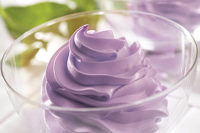Formulating natural colors in dairy foods
Consumer awareness of natural colorings in dairy foods is important. But coloring milk and dairy foods is a tricky proposition. Never fear. We look at red, yellow, blue and green color options for milk, cheese, yogurt and ice cream.










Force of nature
The shift away from synthetic, petroleum-based azo colorants has been a force of nature in the food and beverage industry for some time now. As Joseph Moritz, product manager, human nutrition, BASF Corp., Florham Park, N.J., noted, “Recent events in the United States and Europe have focused more negative attention” on certified colorant options.
For example, the European Food Safety Authority (EFSA) in 2010 slapped warning labels on the synthetic colorants known as the “Southampton Six,” responding to a widely publicized British study that implicated the ingredients in causing hyperactivity in children. Stateside, media coverage of FDA food color advisory panel hearings in 2011 gave Americans an eye into how their own safety watchdogs viewed the hyperactivity research. Though the panel ultimately ruled out warning labels on synthetics for now, it “voted that certain children may be susceptible to them, and further research is necessary,” Moritz said.
That less-than-full-throated endorsement echoes broader uneasiness — especially among parents — about colorants pegged to vaguely ominous FD&C numbers. Those numbers, listed along with the colorants themselves in Title 21 Section 74 of the Code of Federal Regulations (CFR), merely indicate that FDA has certified the compounds for use in foods, drugs and cosmetics. But consumers still find them a little foreboding — if not outright creepy — and that apprehension helps explain why the colors just aren’t as welcome in foods as they used to be.
It’s important to note that manufacturers have used FD&C colors to produce safe and stable hues in foods and beverages for over a century. Even so, perception is reality, and a 2011 Nielsen survey commissioned by ingredient supplier Chr. Hansen revealed that 92% of consumers in 10 countries admit to concern about artificial colorants, and 88% express a preference for natural.
So “instead of waiting for more scientific findings and regulatory action,” Moritz said, “major food manufacturers are asking for options.” Citing data from a 2011 Beverage Industry new product development survey, he notes that “more than 90% of drink developers say they will be using at least some natural flavors/colors this year.”
Looking for a reprint of this article?
From high-res PDFs to custom plaques, order your copy today!










